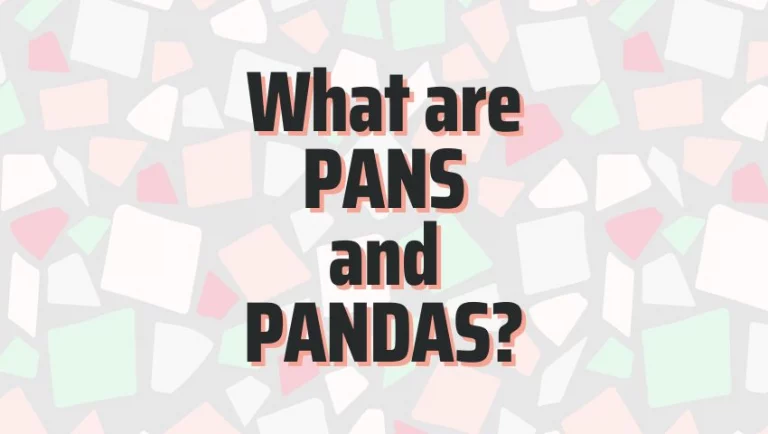PANS and PANDAS are two acronyms that you may have heard thrown around, but what do they actually mean?
What is PANS?
PANS is short for Pediatric Acute-onset Neuropsychiatric Syndrome. It’s a disorder that can cause sudden onset of psychiatric symptoms in children or adults. Symptoms can include OCD, anxiety, tics, mood swings, irritability, aggression, ADHD, regression, and more. PANS can be caused by bacterial and viral infections, autoimmune disorders, exposure to toxic substances like black mold, and even allergies.
What is PANDAS?
PANDAS is short for Pediatric Autoimmune Neuropsychiatric Disorder Associated with Streptococcal Infections. It’s a disorder that is caused by strep. PANDAS is thought to be one type of PANS and symptoms typically start soon after strep exposure.
The exact cause of PANS and PANDAS is not currently known, but there are several theories about what may trigger the condition. One theory suggests that infections and toxic exposures may play a role in triggering the body’s immune system to attack the brain. It is also suspected that genetics may predispose a person to develop these conditions.
Other conditions can also accompany PANS and PANDAS and may help get an accurate diagnosis. My son also had migraines and a condition called POTS, Postural, Orthostatic Tachycardia Syndrome. Other conditions that have complicated genetics, like autism, and EDS, Ehlers-Danlos Syndrome, can often be co-morbid conditions.
PANS/PANDAS Definition
From the ASPIRE website, the definition of PANS/PANDAS is a “misdirected immune response that results in newly abrupt onset or worsening of OCD and/or restricted food intake, concurrently with two neuropsychiatric, cognitive, behavioral, or neurological symptoms in seven categories.”
The seven categories include:
- Anxiety
- Emotional Dysregulation and/or Depression
- Irritability, Aggression, and/or Severe Oppositional Behaviors. This can also include “rages” that are often seen suddenly and out of character
- Behavioral (Developmental) Regression like new baby talk
- Sudden Deterioration in School Performance with signs of change in handwriting or math skills
- Motor (tics) or Sensory Abnormalities like poor tolerance of noises, or wearing clothes
- Somatic Signs and Symptoms, including the new onset of sleep issues, unable to tolerate swallowing, or bedwetting in a child who previously had no problems
It is important to note that not all children will experience all of these symptoms and that the severity of symptoms can vary widely from child to child and are apt to change over time.
How is it diagnosed?
Unfortunately, there isn’t a test for either PANS or PANDAS. It’s a clinical diagnosis. Tests can help paint the picture but it takes a provider who has taken extra steps to learn about it to be able to effectively recognize it and treat it effectively.
Right now there are still many providers who have no idea that PANS/PANDAS is even an actual diagnosis. That’s why there are two great organizations out there whose mission is to teach providers and give them the tools they need to diagnose and treat.
Currently, they are:
- Neuroimmune Foundation – with ongoing physician support and an annual conference with sponsored and free CME.
- PANDAS Physicians Network – with a diagnostic flow chart and treatment protocol based on severity.
What does treatment look like?
The treatment for PANS and PANDAS depends on the underlying cause. If an infection is causing the disorder, then antibiotics may be prescribed. If an autoimmune disorder is to blame, then immunosuppressive drugs and anti-inflammatories may be necessary.
The good news is that many with either disorder improve with early treatment and go on to lead healthy lives.
There is no one-size-fits-all approach to treating PANS or PANDAS, and along with treating the cause, it is also very helpful to manage symptoms.
Some children may benefit from cognitive behavioral therapy or other types of therapy to help them deal with their symptoms. Others may need medication to help manage their OCD, anxiety, or tics. In some cases, a combination of therapy and medication may be necessary.
For cases that were missed at the onset, like my son, there is the potential to become chronic. In these cases, the treatment protocol is escalated and may need more aggressive and expensive treatments like IVIG.
If your child suddenly starts exhibiting strange behaviors or emotions, it could be a sign of PANS or PANDAS. These disorders can be serious, but they are more easily treated if diagnosed early. it is important to talk to your pediatrician so that they can properly assess your child and provide an accurate diagnosis.
To get more information about PANS and PANDAS, please see my resources page. There are links to documentaries, informational videos, and organizations that have provider lists and parental support.
Go here to read our personal story about PANS, PANDAS, and ARFID. Keep reading the blog to see what we are up to now.




